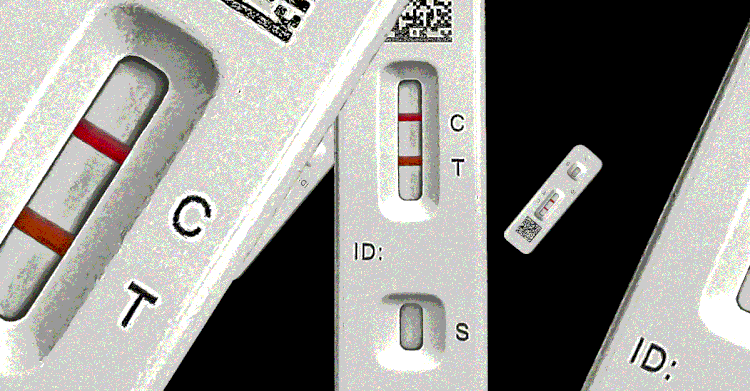In mid-March, I began to notice a theme within my social circle in New York, where I live: COVID—it finally got me! At that point, I didn’t think much of it. Only a few of my friends seemed to be affected, and case counts were still pretty low, all things considered. By April, images of rapid tests bearing the dreaded double bars were popping up all over my Instagram feed. Because cases had been rising slowly but steadily, I dismissed the trend to the back of my mind. Its presence nagged quietly throughout May, when I attended a party at a crowded hotel and hurled myself into a raging mosh pit. As I emerged, sweating, cases were still creeping upward.
Only last week, more than two months later, did cases finally stop rising in New York—but they’ve plateaued more than they’ve fallen back to Earth. If you simply look at the case counts, this surge is not even in the same stratosphere as the peak of Omicron during the winter, but our current numbers are certainly a massive undercount now that rapid tests are everywhere. The same sort of drawn-out wave has unfolded across the Northeast in recent months, and frankly, it’s a little weird: The biggest waves that have struck the region have been tsunamis of infections that come and go, as opposed to the rising tide we’re seeing now. Other parts of the country currently seem poised to follow the Northeast. In the past two weeks, cases have noticeably increased in states such as Arizona, South Carolina, and West Virginia; California’s daily average case count has risen 36 percent. In April, I called the coronavirus’s latest turn an “invisible wave.” Now I’m starting to think of it as the “When will it end?” wave.
Consider New York City, which by this point has been the epicenter of several waves, including the one we’re dealing with now. When Omicron arrived last fall, cases jumped very quickly as the new, more transmissible variant broke through existing immune defenses and infected lots of people, who spread the virus like wildfire. A combination of factors quickly extinguished the flame: People got boosted, the public-health messaging changed and some people changed their behaviors, and eventually so many had gotten sick that the virus had fewer people to infect. That’s not what seems to be happening now. For one thing, the shape of the curve feels different: From December 2021 to mid-February 2022—about two and a half months—Omicron erected a skyscraper on the charts. Since March, the current wave has drawn just the rising half of what looks to be a modest hill—and, again, the true shape is much taller. Broadly, the same trends have played out elsewhere, too. Now it’s June, and fresh images of rapid-test results are still circulating within my social circle. Why has this wave felt so different?
The major reason, public-health experts told me, is that Americans, on the whole, are more protected against COVID now than they were during previous times when infections have soared. Omicron was a completely new variant when it first hit during the winter, and it swept through a large chunk of the country. “We built a lot of immunity due to so many people getting sick,” Marisa Eisenberg, an epidemiologist at the University of Michigan, told me. So far, that immunity seems to dampen the spread of the two new forms of Omicron that are behind the current, stretched-out wave of cases. “It’s imperfect, but it’s at least some protection,” Joe Gerald, a public-health professor at the University of Arizona, told me. “As we take people out of the susceptible pool, basically the math works against a large and fast outbreak, so it would tend to slow transmission and make the size of the wave smaller.”
Another major factor at play is the onset of warmer weather, especially in colder parts of the country. School’s nearly out, if it isn’t already, and though people are getting together and traveling more, they’re likely doing so outdoors. In other words, even if people are getting infected with new Omicron strains, they’re not able to spread it as efficiently. “These aren’t ideal transmission conditions for this usually winter virus,” Gerald said. Seasonality may also be one reason that cases first rose in the Northeast, given that the “When will it end?” wave began when it was relatively cooler and people were inclined to gather indoors.
The UCLA epidemiologist Tim Brewer said he’s confident that COVID is settling into similar seasonal patterns as illnesses such as the flu and the cold. We’ve seen smaller waves before outside of the winter months, he pointed out. “What’s going on right now is very similar to what happened if you look back at 2020, around June through July. It had this gradual rise in cases and then things kind of leveled off for a while. Hopefully [soon] they’ll level off.” That being said, what we’re seeing now is not identical to earlier stages of the pandemic: Reported cases are much, much higher now versus in summer 2020, and that’s before you account for all the missed infections right now. Also the onset of the summer 2020 wave was not as maddeningly slow as this one has been.
Meanwhile, reported cases are continuing to climb in other regions, namely the South and Southwest. That raises the uncomfortable, frustrating possibility that we’ll be stuck in this wave for quite some time. But then again, even that is hard to know right now, especially as our view of basic pandemic numbers is so murky. “What makes it difficult to understand how a new wave might play out is that we’re still struggling to understand what the size of our susceptible population is, how many people have truly been infected, and how quickly immunity wanes from both vaccination and prior infection,” Gerald said. Eventually, as we learn more about this virus, we might get better at predicting its next turn. But for now, “there’s also going to be weirdo surges that happen whenever they happen,” Eisenberg added.
There’s no sugarcoating it: The “When will it end?” wave is frustrating. We’re entering our third pandemic summer, and yet again cases are high enough that activities such as indoor dining and weddings can come with a real fear of getting sick. But that pattern of slow and steady spread has benefits as well. It’s exactly what we need to prevent our health-care system from getting overwhelmed—with all the side effects of delayed procedures and hospital burnout that comes along with that. Some 25,000 Americans are currently hospitalized with COVID, compared with more than 150,000 at the height of Omicron. There’s a reason “flatten the curve” became an early pandemic slogan—by drawing out infections, we’re helping to ensure that hospitals have space for us when we need it, whether that’s for COVID or any other reason.
But we shouldn’t get too comfortable. This winter could be bad once again—the Biden administration predicts that we’ll see 100 million new cases during the fall and winter, and a new variant could still worsen that outlook. Such a dire situation is not inevitable, though. If anything, the “When will it end?” wave is a reminder that dramatic, all-consuming surges are not necessarily our destiny. Slowing this virus down, whether that’s through vaccinations or ventilation upgrades—or, in this case, the fortunate coincidence of immunity and weather—can go a long way. “The more we interfere with the ability of this virus to replicate and transmit, the fewer the cases will be, and the less we interfere with its ability to replicate and transmit, the more cases there will be,” Brewer said. “It’s just as simple as that.”
Source by www.theatlantic.com


